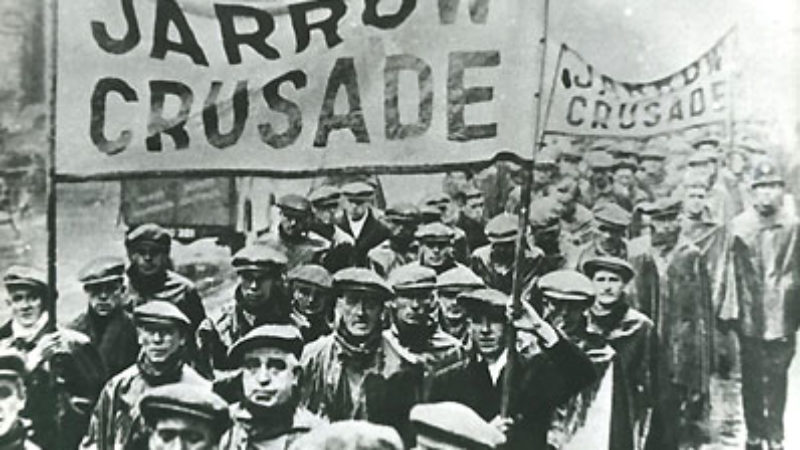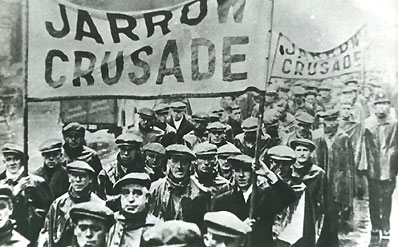

Since the end of the second world war many people have seen the period between the two conflicts as one of unmitigated economic failure, marked by mass unemployment and hunger marches, including the famous Jarrow March of 1936. For the historian Claude Cockburn this was the “devil’s decade”.
However, this popular view has been challenged by Stuart Maconie in his new book Long Road from Jarrow. He points out that, although there was great hardship in the 1930s, especially in the north east, it was very unevenly spread out.
The deprivation was real, particularly for those who lived in the depressed areas of Tyneside and County Durham. For instance, between 1854 and 1913 the output of British coal had grown from 65 to 287 million tons. But, by 1934, it had fallen. In human terms the ruin of the traditional industries, such as shipbuilding and mining, was the ruin of hundreds of thousands of men through mass unemployment. Certainly to live in Jarrow was a grimmer experience than to live in midlands areas like Market Harborough. In 1936, Jarrow resembled a ghost town with more than 80 per cent of the town’s men jobless.
The Durham town of Ferryhill experienced an unemployment rate of 25 per cent. The effects were devastating as shops, pubs and other businesses were forced to close. Families fell into debt. Diets suffered and health deteriorated. The “dole” was meagre and the “means-test” was often applied in a harsh and heartless manner. Today, although unemployment is low, millions experience the insecurity and low wages of the gig economy while jobseeker’s allowance has been frozen for the second year. Over a third of claimants have been ‘’sanctioned’’ at one point in the last 12 months.
There has been a sharp rise in precarious self-employment and zero hours contracts. Under austerity, the number of northerners using food banks has soared. The Trussell Trust gave out more than one million food parcels in 2016.
As Maconie notes, “the 30s in some ways start to look very much like Britain today, once you’ve wiped away the soot and coal-dust.’’
Social class, for Maconie, is alive and well. It’s the principal divison of British society as he reflects upon the north-south divide through his 2016 journey from the post-industrial towns of Jarrow and Barnsley to the southern market towns of Bedford and St Albans. The former industrial town of Ferryhill today is “a mining town with no pit” he writes.
Yet as Newcastle University historian Norman McCord points out, towns like Hebburn – three miles from Jarrow – were hard hit but escaped the worst ravages of the inter-war recession. At the same time the leafy neighbourhood of Gosforth remained untouched, with virtual full employment, not unlike the situation today. Even in High Heaton and Cowgate new council housing was being built for the so-called “respectable working-class”. With interest rates low, then new mock owner-occupied Tudor semis were being built in Kenton and North Gosforth from 1934 for professionals in the private sector.
Nor did the era produce a potential revolutionary situation or extremism as predicted by many contemporaries at the time. Although membership of the Communist Party grew from 2,500 in 1930 to 17,500 by 1939, it made very few advances. Likewise as the Newcastle historian Martin Pugh points out, Mosley’s black shirts made little impact in the region even though the British Union of Fascists had over 30,000 members by 1935.
The 1930s were in several areas a period of growth and socio-economic expansion. The well-established light industries of the midlands and Gateshead’s Team Valley in 1937 – although they had always met the demands of the domestic consumer – found themselves faced with a rapidly expanding mass market. Inexpensive consumer items such as vacuum cleaners, radios and electric irons flooded the market and were bought in vast quantities by 1939. Department stores, especially Woolworths, grew rapidly.
As the decade witnessed marked shifts in the economy in both the midlands and the south, leisure too became transformed. In 1920 there had been about 500,000 motor vehicles of all kinds. By 1932 there were three times as many. And by 1939 that figures had doubled. Of the three million vehicles on the roads, two million were private cars. In Oxford, traffic jams had become a familiar bank holiday event. In 1931 only 1.5 million people were entitled to paid holidays. By 1939 this figure had risen to 11 million.
Caravans, Butlins holiday camps, and particularly cinemas were becoming a familiar sight. The number of visits to the pictures rose from 36,000 in 1924 to eight million by 1935. The Odeon, Royalty and Jesmond picture houses were packed out every weekend. The avant-garde Tyneside cinema is celebrating its 70th anniversary.
Throughout the thirties the cost of living fell a third faster than wage rates. Those in work, like office-based “black-coated workers” and skilled artisans, enjoyed a rise of 17 per cent in real incomes from 1924 to 1935.
In his classic work, English Journey, JB Priestley noticed the paradox that prevailed: mass unemployment and poverty for one section of the working class living in the north east and a rising standard of living for another section.
“This is the England of arterial and by-pass roads, of filing stations and factories that look like exhibition buildings, of giant cinemas and dance-halls and cafes, bungalows with tiny garages, cocktail bars, motor coaches, wireless, hiking, factory girls looking like actresses, greyhound racing, swimming pools and everything given away for cigarette coupons,” Priestley wrote.
Eighty years on and writers like Stuart Maconie note that we are going back to the thirties with rising austerity, social inequality and the growth of far-right populism. A gross simplification, argue others.
Yet it cannot be denied that today we are seeing a widening gulf both between the north and south of England. Just as worrying is that we appear to be witnessing a big gap opening up in our core cities such as Newcastle, Leeds and Manchester. Compare and contrast Parklands in Newcastle with its lavish suburbs, high levels of conspicuous consumption and packed restaurants to that of the inner-city and outer council estates, with high levels of deprivation, ill-health and insecure jobs.
Maconie is correct to emphasise making our country a “one-nation society” again. But we also need to strive for a “one region society”, if we’re serious about creating a more equitable and fairer community which benefits the many and not the just the few.
Stephen Lambert is a Newcastle city councillor and former lecturer in sociology, history and politics.
Long Road from Jarrow: A Journey Through Britain Then and Now by Stuart Maconie is published by Ebury Press.




More from LabourList
New intake Labour MPs: ‘Why we set up the Living Standards Coalition’
Andrew Pakes MP: ‘We need blue-collar Labour, not Blue Labour’
LabourList readers reveal their highs and lows of Labour’s first year